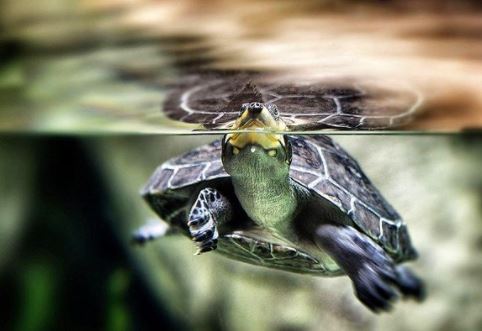Can you keep your turtle tank outside?
This blog post will be about whether you can keep your turtle tank outside. Turtles are usually kept in tanks to live and eat, but if the environment is right, they don’t need to be inside a tank.
Before you get an outdoor turtle enclosure, there are some things that need to be considered first.
The following blog post will help guide you on what type of enclosure suits your needs best for keeping turtles outside their tank.
Related Posts:
- Top 5 Turtle Substrate for Your Pet Tank
- How to Make UV Light for Turtles?
- Do Turtles Need Light 24 Hours a Day?
- Can Turtles Live in a Fish Tank Filled With Water?
- Can I Use a Fish Water Conditioner for Turtles?
Can I Keep My Turtle Tank Outside?
Can you keep your turtle tank outside?
Yes, you can keep your turtle tank outside. In some countries, there is a tradition to have turtle tanks outside in the garden.
In Germany, for example, it is common to have turtle pools over several years and then rebuild them. However, it really has only advantages if you do everything right!
And that’s why you should not deal with turtles in an “experimental way.” You should always think about how to protect turtles from any harm.
In the case of outdoor keeping, the following should be considered:
1. Outdoor Turtle Tanks Must Be Escape-proof
Turtles can dig out quite well if they want to! It may not only risk the animals but also people and animals from the surroundings!
Do a good job with the flooring and make sure that turtles cannot get out (by adding a wire mesh to the tank) or other animals in!
2. Outdoor Turtle Tanks Must Be Well-protected From Attacks
Outdoor turtle tanks must be well protected from any attack by both people and animals!
Turtles may not only bite fingers but also dogs and cats can “bite” turtles. In addition, a dog might dig a hole into the sand bed and suffocate the inhabitants of the pool to death.
3. The Temperature in Winter Should Never Fall Under 5-10°C
Turtles are reptiles, so they have no significant internal fur to keep them warm!
They need a body temperature of 30-35°C to stay healthy! If this is not guaranteed, there is a high risk of infection!
Use heaters (infrared lamps) to maintain the necessary temperature, but make sure that they can not be reached by turtles directly (and certainly not by small children).
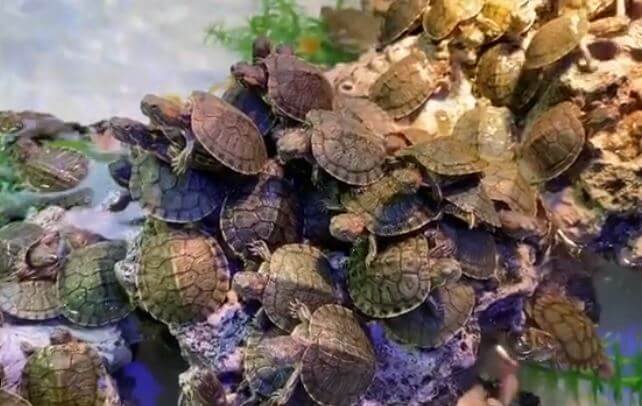
4. Light Conditions Should Be Optimal During Summer and Winter
Turtles are diurnal animals that need a certain amount of daylight for their biological clock so that they can rest at night adequately.
An appropriate day length is important for breeding as well. This means full lighting in summer.
In winter, however, you can use so-called secondary lights or UVB tubes since there are no longer any reptiles outside the enclosure.
For example, you can still see your turtle in December, but it’s probably already gone back into hibernation.
By the way, if turtles are kept outdoors, they should always get a day-night cycle by artificial lighting!
5. Turtles Must Be Able to Swim Over and Dive Down
The pool must therefore not be too small (at least 1 x 1 meter and deeper than 40 cm) and filled up without any problem after use ( do not let old people or children fill it up).
Also, make sure that you can easily clean all corners of the pool!
Can Turtles Stay Outside in Winter?
Can you keep your turtle tank outside even in winter?
Turtles are cold-blooded ectothermic animals. This means their body temperature is controlled by the surrounding environment.
Since they cannot produce their own body heat, they rely on external sources to maintain a high enough internal temperature for normal bodily functions.
They also require an adequate source of ultraviolet (UV) light for the synthesis of vitamin D3 in their skin, which will help them absorb the calcium needed for strong bones and egg development.
The ideal limits for keeping turtles under outdoor conditions are 60-80°F during the day and 45-65°F at night with exposure to full sunlight or UVB lamps between 10 AM and 4 PM daily all year round, except when temperatures drop below 45 degrees Fahrenheit.
At this point, it is advisable to bring your turtles indoors and into a secure enclosure.
Temperatures below 45 degrees Fahrenheit can cause respiratory infections in turtles, known as shell rot, which is fatal if not treated promptly.
If you have the ability to provide these types of conditions for your pet turtle, they will be able to survive happily outdoors during the winter months.
However, it is important to remember that even though turtles may look tough on the outside, their internal organs are very sensitive to drastic changes in temperature.
Turtles can freeze solid and suffer from organ damage without proper precautions!
For this reason, we recommend turtles be brought inside when temperatures reach below 40°F or above 85°F.
In addition, it’s best to get them out of direct sunlight if the surface temperature reaches over 85°F.
This is when they are most likely to get heatstroke and suffer organ damage or even death.
If you decide to bring your turtle inside for the winter, make sure the enclosure receives full sunlight or UVB-emitting lamps during the day and that nighttime temperatures do not drop below 60 degrees Fahrenheit in order to maintain a healthy body temperature.
Also, provide clean water at all times and an area of land for them to bask under the lamp in order to absorb needed vitamin D3, just like they would outdoors.
Be sure not to place the basking light too close, however!
Their shell can quickly reach lethal temperatures if it is allowed to get too hot. If you keep this up year-round, your pet will be healthy and happy indoors as well as out.

Can Painted Turtles Live in a Pond?
Now that you know that you can keep your turtle tank outside, can turtles, specifically painted turtles, live in a pond?
The painted turtle is one of the most common species of turtle, but you may have never thought about having them as pets.
They are invasive to some areas and not native to many regions. So if you want a pet that can stay outside or travel around, this might be an option for you to consider!
If you’re curious if painted turtles can live in a pond, then I’m here to give you all the information you need about these wonderful creatures!
Let’s start with the basics.
The painted turtle is considered an aquatic animal because it spends most of its time in freshwater bodies like ponds, lakes, streams, rivers, and even itches.
But unlike your goldfish, a painted turtle can also live on land for periods of time. They use their sharp claws to walk around in search of insects and earthworms.
How they move is absolutely fascinating! You may have even seen a painted turtle walking up onto a rock near the water’s edge with its nose pointed toward the sun.
What is it doing? It’s trying to warm itself because when temperatures drop at night, these creatures will hibernate until spring comes around again.
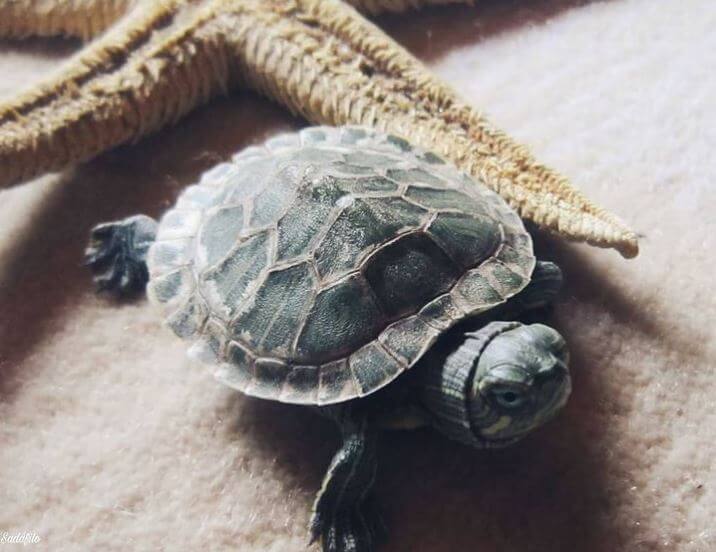
So back to my original question: Can painted turtles live in a pond? Well, yes, but only if you want them to!
But what about the temperature in your pond? If your pool doesn’t get very cold in winter or has a heater so turtles can survive during those cold months, you might be okay.
But if your pool is just like the ponds these turtles come from and gets way too cold or freezes over in winter, then you’ll probably need to bring them inside where it’s warm.
So what do painted turtles eat? Since they’re omnivores, they eat a variety of insects and earthworms as well as aquatic plants like water lilies!
Expert tip: If you don’t want turtles eating all the algae (and eventually killing) your precious pond plants, there are special products out there that will make your water less appealing to them.
Painted turtles are very easy to care for, but there are a few things that you need to know before you go out and get one.
First of all, these turtles can live up to 40 years. That’s right — 40 years!
Order your turtle in the mail like it’s an Amazon package and you’ll be surprised how much they grow in short periods of time.
So you’ll want to make sure this is something you’re ready for because owning a pet, in general, is a big responsibility for anyone!
Another thing is that, since they spend most of their time in the water, they love playing around in shallow ponds where their shell loads can touch down on land, but not too far away from water (just like a regular turtle).
Their water time is vital to their survival because it’s where they warm up and get a lot of nutrients from its salt content.
You’ll definitely want to invest in a heater for your pond if it doesn’t freeze over during the winter months!
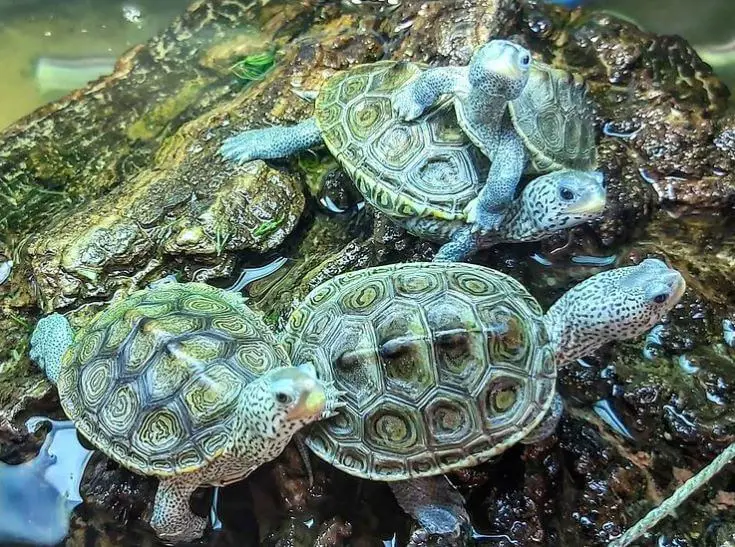
What You Should Know About Outdoor Turtle Pond Red-eared Sliders?
Outdoor turtle pond red-eared sliders (Trachemys scripta elegans) are the most common pet turtle in the world, with over 1.5 million individuals exported annually into the American marketplace.
This is particularly concerning when considering that adult female red-eared sliders can lay up to 30 eggs at a time and many turtles do not reach sexual maturity until their late teens (3-4 years old).
The problem of captive breeding originates with aquatic turtle farms in Asia and Mexico where turtles are collected from the wild, artificially hatched en masse, then placed into cultivation ponds before being provided for sale at local markets.
Although there may be only 20% hatchling mortality during this process, it does nothing to conserve wild populations or reduce demand for indigenous turtles.
It merely provides a loophole in the law, allowing for these animals to be sold in markets legally instead of being smuggled in from other countries.
The red-eared sliders that are native to North America have been incredibly popular as pets since they were first found in the 1960s because of their playful personalities and tendency to grow large enough to make them a rewarding pet.
In fact, many turtle owners report difficulty releasing their turtles back into the wild when they become too large or aggressive to properly care for.
This leads to the purchase of another turtle by well-intentioned owners who adopt from rescues or purchase from breeders, perpetuating demand and growth of local populations.
Research has shown that up to 75% of red-eared slider hatchlings do not survive their first year of life, and this is likely due to many factors such as dehydration, predation, and long-term effects of the global trade on wild populations.
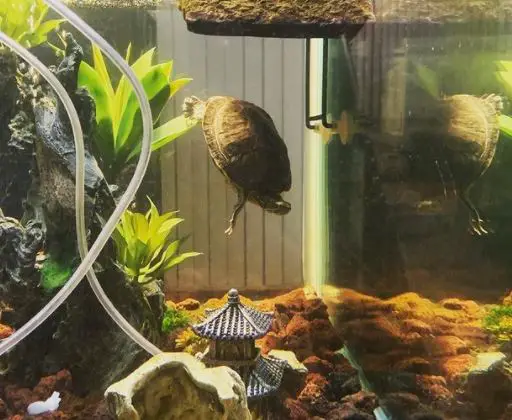
As with most species that are sold in pet markets around the world, red-eared sliders lack any kind of federal protection under CITES (Convention on International Trade in Endangered Species ) or US Lacey Acts that prohibit interstate transport with no permit.
This has meant that there has been little enforcement towards people smuggling turtles across borders by train or bus from Mexico into America, leaving these reptiles vulnerable to massive-scale smuggling operations.
In fact, it wasn’t until 2010 when the Turtle Conservation Act made it illegal for individuals who were not registered wildlife breeders to sell turtles under 4 inches long that there was any kind of regulation towards the trade.
The lack of regulation meant that many thousands of juvenile turtles were still being shipped into America each year, with some sources now estimating 10-20 million imported annually.
The legal loophole allowing individuals to purchase red-eared sliders from Bavarian Aquaculture companies in Mexico has led to a recent increase in demand for these animals by breeders and pet stores across America.
The company requires buyers to sign a contract agreeing not to release their turtle into the wild if they are unable to provide proper care, but this is not always enforced or legally binding.
This allows owners to simply dump their pets off at a nearby lake or pond if they become problematic to keep in captivity, which is certainly not good for the ecosystem.
The red-eared slider’s main food source is native snails, which can be hard to come by in the wild, so the turtles could easily starve to death out of their natural environment.
Since turtles often live up to 50 years, it is vital that owners research proper care before adopting one.
Red-eared sliders should only ever be housed indoors or kept with a very large body of water (minimum 50 gallons) and require high basking areas (often limited due to housing conditions), UVB bulbs, and warm water.
They also need tank companions like small fish or crawfish as well as dry land areas where they will naturally bask under a heating light.
Although turtle owners have grown accustomed to keeping these animals in simple, easy-to-clean tanks or tubs for many years, it is absolutely vital that they adapt their care to meet the specific needs of this species.
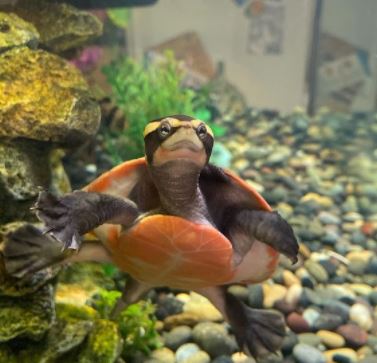
How to Build an Outdoor Red-eared Slider Turtle Habitat?
Since I started creating my first red-eared slider turtle habitat, I’m often asked by people who are thinking about buying their first pet turtle how they should go about building their own outdoor turtle pond.
This is one of the most common questions that people ask me.
Whether you’re new to keeping turtles or not, if you want to build your own pond, you’ll need some plans.
Before we start speaking specifically about ponds and how to build them for red-eared sliders, it’s important that we first cover some very important background information regarding these aquatic reptiles.
It is this knowledge base that we will draw upon as we discuss building ponds.
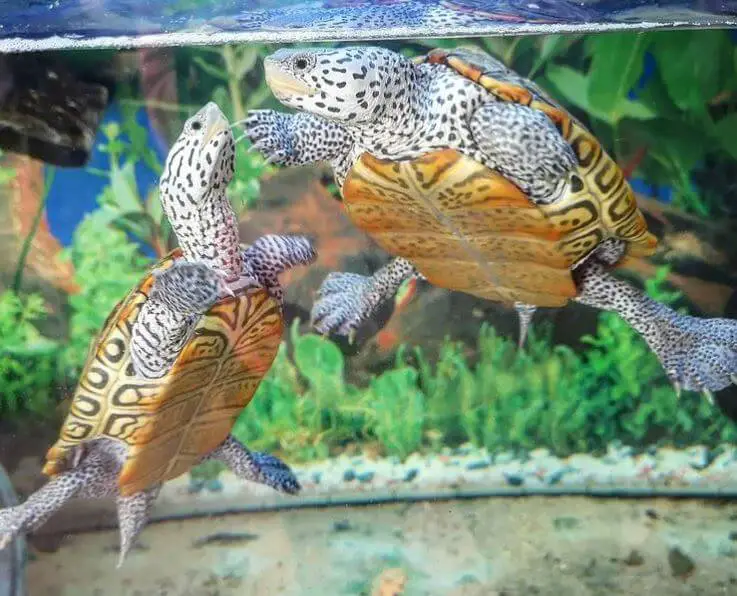
Where Should I Keep My Red-eared Slider Turtle?
Turtles are reptiles and thus require specific conditions to meet their physical, physiological, and behavioral needs. Not just one or two of these but ALL of them.
Turtles do not adapt to underwater life very well, so it is the keeper’s responsibility to provide adequate living substrate (water), natural lighting/UVB radiation, proper temperature, and dietary requirements along with mental enrichment for his captive turtle.
However, instead of focusing on what you need to provide for your turtle, let’s first take a look at where you should house your pet turtle.
According to Dr. Peter C Klapperich DVM, if the aquarium has a screen cover, the turtle should be able to get out of the water and bask.
Basking is a crucial activity for aquatic turtles and all basking areas must allow easy access in and out of the water.
A dry area with good air circulation is necessary because when they are active, aquatic turtles that produce considerable amounts of moisture from their respiratory surfaces, which can cause respiratory problems if not vented properly.
They also need a place where they can completely submerge themselves to rest or swim in deep water when desired.
Again, this area must have good air circulation at the surface in order not to accumulate excessive amounts of carbon dioxide, which can cause health problems.
Turtles should be checked regularly for signs of trouble.
The eyes should be clear and the skin free from cuts or abrasions.
Turtles require a certain amount of exercise in order to maintain good health and water aerobic organisms, such as mosquito larvae, so provide an excellent source of additional exercise.
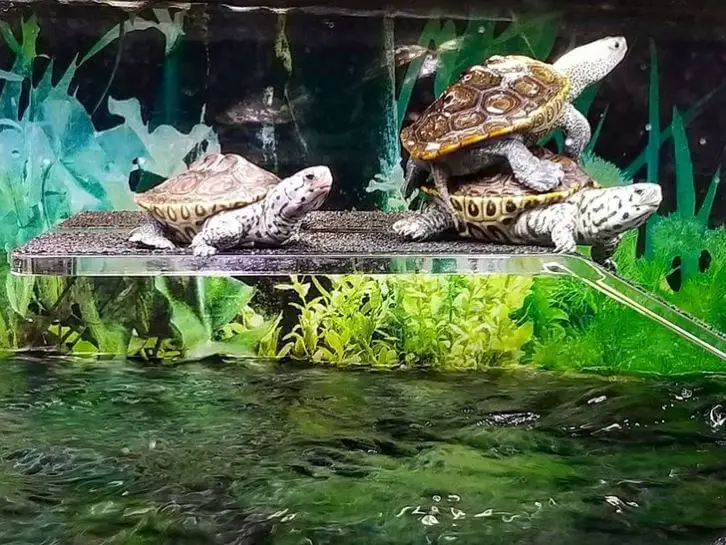
Aquatic turtles are very difficult to keep healthy in captive environments that do not meet their requirements for swimming space, natural sunlight or UVB radiation exposure, plants, or live food with a high calcium content.
A small aquarium with the dimensions of 20 inches long x 10 inches wide x 12 inches deep (or 50 cm x 25 cm x 30 cm) is far too confining for an aquatic turtle regardless of its size.
They need enough room to swim around without bumping into things, so there should be at least 40 gallons of water volume per adult red-eared slider (100L/20″ x 50″/25 cm).
If you can provide him with an even larger environment, so much the better.
Aquatic turtles require heat and light for proper health and care. The light should be left on 12-14 hours a day for hatchlings and juveniles and around 10 hours a day for adults.
A heating pad or tape may be used to provide some belly heat by securing it beneath half of the water tank under one side of the basking platform (basking spot) on one end of the tank.
This will cause blood vessels in that area of their body to dilate, thus permitting them to absorb more UVB radiation from overhead lighting when they are positioned properly in direct sunlight, which is never totally obscured from above.
Water temperature should be maintained at around 75-78°F (24-26°C).
To provide heat, an aquarium heater mounted inside near one end of the tank on the outside of the glass with suction cups may be used. The basking platform must float free in its chosen location.
Conclusion
Can you keep your turtle tank outside? Yes, you can keep your turtle tank outside!
Nonetheless, turtles are reptiles and cold-blooded. They require a temperature gradient to regulate their body temperatures, which is why they need an indoor habitat that can be heated or cooled depending on the season.
It’s also important that your turtle tank doesn’t have any plants because turtles may eat them while you’re away from home!
If this sounds like too much work for you, we recommend adopting a pet bird instead of trying to keep your turtle in its natural environment outdoors.
Key take away points for whether you can keep your turtle tank outside:
Keeping a turtle tank outside can provide a more natural environment for your pet while allowing you to enjoy them in an outdoor setting. However, there are several important factors to consider before making this decision. Here’s a guide with key points to keep in mind:
Pros of Keeping Your Turtle Tank Outside:
- Natural Sunlight: Turtles benefit from natural sunlight, which provides essential UVB radiation for proper calcium metabolism and shell health.
- Enhanced Space: Outdoor enclosures can be larger than indoor tanks, allowing your turtle more space to move around and explore.
- Fresh Air: Outdoor environments offer fresh air and more natural humidity levels, which can benefit your turtle’s well-being.
- Natural Behavior: Turtles often exhibit more natural behaviors, such as basking and foraging, when kept in outdoor enclosures.
- Aesthetics: An outdoor turtle habitat can be an attractive addition to your outdoor space, creating an appealing focal point.
Cons of Keeping Your Turtle Tank Outside:
- Climate Considerations: Outdoor enclosures are weather-dependent. You must consider your local climate and the specific needs of your turtle species.
- Predator Risk: Outdoor enclosures are more susceptible to potential predators, such as raccoons, birds, and other animals that can harm or stress your turtle.
- Temperature Fluctuations: Temperature variations can be significant, so you’ll need to provide shade and shelter for your turtle to prevent overheating.
- Maintaining Water Quality: Algae and debris can accumulate more rapidly in outdoor water features, requiring more frequent cleaning and maintenance.
- Escape Risks: Turtles may attempt to escape, and outdoor enclosures must be secure to prevent your pet from wandering off.
Important Considerations for an Outdoor Turtle Tank:
- Secure Enclosure: Ensure your outdoor enclosure is escape-proof and provides protection from potential predators.
- Shade and Shelter: Offer areas for your turtle to hide and escape direct sunlight to prevent overheating.
- Heating and Lighting: Consider providing supplemental heat and UVB lighting for periods when natural sunlight is insufficient.
- Water Features: Keep water quality in check by regularly cleaning and maintaining your turtle’s pool or pond.
- Local Regulations: Check local regulations and zoning restrictions that may affect keeping turtles outdoors.
- Species Specifics: Different turtle species have varying requirements, so tailor the outdoor enclosure to meet their specific needs.
- Daily Supervision: Regularly observe your turtle to ensure they are safe and healthy in the outdoor environment.
Keeping your turtle tank outside can offer numerous benefits but requires careful planning and attention to various factors, including climate, safety, and enclosure maintenance. Always prioritize the well-being and safety of your turtle when making the decision to maintain their habitat outdoors.
Further Reading:
- 7 Best Plants for Turtle Tank
- 5 Best Turtle Basking Platforms
- Can You Put Fake Plants in a Turtle Tank?
- How Big of a Tank for a Painted Turtle?
- Can You Put Sand in Your Turtle Tank?

